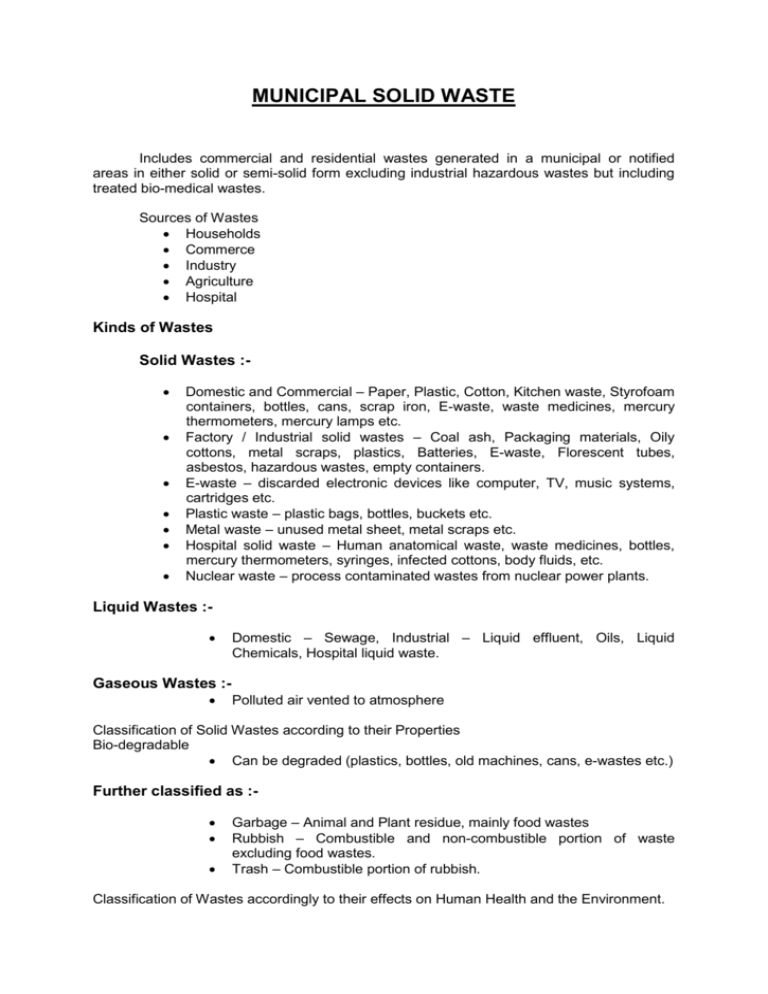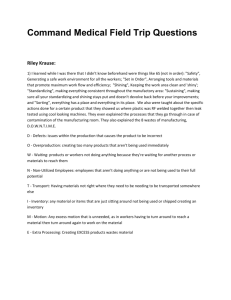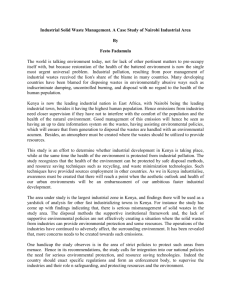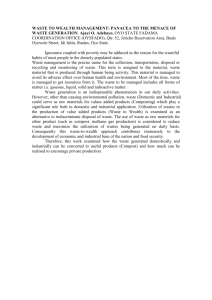MUNICIPAL SOLID WASTE Includes commercial and residential
advertisement

MUNICIPAL SOLID WASTE Includes commercial and residential wastes generated in a municipal or notified areas in either solid or semi-solid form excluding industrial hazardous wastes but including treated bio-medical wastes. Sources of Wastes Households Commerce Industry Agriculture Hospital Kinds of Wastes Solid Wastes : Domestic and Commercial – Paper, Plastic, Cotton, Kitchen waste, Styrofoam containers, bottles, cans, scrap iron, E-waste, waste medicines, mercury thermometers, mercury lamps etc. Factory / Industrial solid wastes – Coal ash, Packaging materials, Oily cottons, metal scraps, plastics, Batteries, E-waste, Florescent tubes, asbestos, hazardous wastes, empty containers. E-waste – discarded electronic devices like computer, TV, music systems, cartridges etc. Plastic waste – plastic bags, bottles, buckets etc. Metal waste – unused metal sheet, metal scraps etc. Hospital solid waste – Human anatomical waste, waste medicines, bottles, mercury thermometers, syringes, infected cottons, body fluids, etc. Nuclear waste – process contaminated wastes from nuclear power plants. Liquid Wastes : Domestic – Sewage, Industrial – Liquid effluent, Oils, Liquid Chemicals, Hospital liquid waste. Gaseous Wastes : Polluted air vented to atmosphere Classification of Solid Wastes according to their Properties Bio-degradable Can be degraded (plastics, bottles, old machines, cans, e-wastes etc.) Further classified as : Garbage – Animal and Plant residue, mainly food wastes Rubbish – Combustible and non-combustible portion of waste excluding food wastes. Trash – Combustible portion of rubbish. Classification of Wastes accordingly to their effects on Human Health and the Environment. Hazardous wastes Substances unsafe to use Explosive Flammable liquids Flammable solids Oxidizing substances Poisonous substances Infectious substances Corrosives Non-hazardous Substances safe to use. Not having the above characteristics Effects of Waste if not managed wisely. Affects our health Affects our socio-economic conditions Affects our environment Affects our climate What should be done Adopt an ecologically sound waste management system which includes : Waste Reduction More Efficient Collection Segregation at Source Recycling and Re-use Composting Management of Municipal Solid Waste of Talcher Municipality Introduction :The Solid Waste Management Department of the Talcher Municipality headed by one Assistant Health Officer, one Sanitary Inspector, three Zamadar, five driver and 109 nos. of Sweepers & Sweepress & one disinfector. The overall responsibility of Solid Waste Management of the town rests with Executive Officer of the Municipality. At times when the requirement of the Sweepers increases particularly in festive seasons and during rains the department also hires extra sweepers. Waste Generation / Day / Talcher Municipality At present Talcher Town generates about 15 MT of Solid Waste per day. The per capita waste generation is 0.4 Kg. / day. The source wise generation of waste is given below. Sl.No. Source 1 2 3 4 5 Sl. No. Parameters 1 Collection of Municipal Solid Wastes 2 Segregation of Municipal Solid Wastes 3 Storage of Municipal Solid Wastes Approve Qnty. In MT House holds Street Sweeps Veg, fish & Meat market Hospitals and Nurshing homes Institution / Industry TOTAL 4.0 6.0 4.0 0.5 0.5 15.0 MT Description of Work (a) Organising house-to-house / door to door collection of Municipal Solid Wastes through community bin collection (central bin), house-to-house collection, collection of regular pre-informed timings and scheduling by using bell ringing of musical vehicle (without exceeding permissible noise levels) (b) Devising collection of waste from slums and squatter areas or localities including hotels, restaurants, office complexes and commercial areas. (c) Wastes from slaughter houses, meat and fish markets fruits and vegetable markets, which are biodegradable in nature, are managed to make use of such wastes. (d) Collected waste from residential and other areas one transferred to community bin by hand-driven containerised carts or other small vehicles. (e) Horticultural and construction of demolition wastes generated are regulated. (f) Waste (garbage, dry leaves) are not burnt. (g) Stray animals are not be allowed to move around waste storage facilities or at any other place in the town and managed in accordance with the State laws. (h) The Executive Officer notified waste collection schedule and the likely method are adopted for public benefit of Talcher. In order to encourage the citizens, Executive Officer have organised awareness programme for segregation of wastes and shall promote recycling or reuse of segregated materials. The Municipal Authority have undertake phased programme to ensure community participation in waste segregation. For this purpose regular meetings at quarterly intervals have been arranged by the Executive Officer with representatives of local resident, welfare associations and non-governmental organizations. Municipality have established and maintain storage facilities in such a manner as they do not create unhygienic and insanitary conditions around it. Storage facilities are created and established by taking into account qualities of waste generation in a given area and the population densities. A storage facility have been identified so placed that it is accessible to users. Storage facilities are set up by Municipality & so designed that wastes stored are not exposed to open atmosphere and shall be aesthetically acceptable and user-friendly. Storage facilities or ‘bins’ are ‘ easy operate’ design for handling transfer and transportation of waste. Bins for storage of bio-degradable wastes have been painted green, those for storage of recyclable wastes are painted white and those for storage of other wastes are painted black. Manual handling of waste are prohibited. If unavoidable due to constraints, manual handling are to be carried out under proper precaution with due care for safety of workers. Sl. No. Parameters 4 Transportation of Municipal solid Wastes Description of Work Vehicles such as 4 nos. of Tractor, 1 truck, 2 Nos. Auto tippers, 21 trolley rickshaw & 50 Nos. wheel barrows are being used for transportation of wastes. (a) The storage facilities set up by Municipality have daily attended for clearing wastes, The bins or containers wherever placed are being cleaned before they start overflowing. (b) Transportation vehicles are so designed that multiple handling of wastes, prior to final disposal is avoided. Waste Disposal One landfill site have been earmarked comprising area 10 Acre of land situated at Rani Park of Talcher Municipality which is 0.5km. away from habitation clusters for disposal of residual solid wastes on land in a facility designed with protective measures against pollution of ground water, surface water and cur fugitive dust, wind-blown litter, bad odour, fine hazard, bird menance, pests or rodents, slope instability & erosion. Use of Bleeching Disinfection of wells and toilets made by Municipality, Ghats of Municipal ponds, disinfection of public placed during festival time. Use of lime Lime is being used to clean the Municipal pond water periodically. Spaying Biotex Biotex is sprayed by 2 Nos. of spray machines regularly to kill mousquitos as well as insects. Putting Malaria Oil Malaria oil is used in various drains of Municipality area and places of water stagnation to disinfect the breeding places mosquitos and insects. Use of Cesspool :One cesspool has been used to clean the septic tanks of night soil and also used to empty the water from collected pits. Use of Fogging Machine Two nos. of Fogging Machine have been used to kill mousquitos regularly in Municipality area. Water Tanker 5 Nos. of water tanks are being used to supply drinking water at water scarcity area during summer season & at the time of requirement of public in other seasons. PLASTIC WASTE MANAGEMENT OF TALCHER MUNICIPALITY Plastic waste management has assumed great significance inview of the Urbanisation activities. Municipal Solid Waste contain 1-4 percent by weight of plastic waste. Plastic waste from a wide range Discarded PVC chappals / shoes in various colours a grades of plastic materials. Discarded PVC mineral water bottles / PET mineral water and liquor bottles and PS Ice cream / cold drink cups / disjosble catterring plates and grays and expanded PS and PE foam packagings. PE, PVC, PP films, packages, shopping bags and medicine foils, used and owscarded moulded items like containers and range of household non-darable, combs, ball point, pens, tooth brushes etc. Progress plastic articles mostly of PE, PVC, PS, PP, ABS, Nylon PET etc. Steps Taken :- Removal of plastic waste by Talcher Municipality As per letter No. 7558/HUD, dt. 27.03.2010 of Housing & Urban Development Department, Govt. of Orissa, Talcher Municipality have collected bio degradable non-biodegradable plastics / polythenes deploying daily labours / rag pickers from the garbage waste & transport them to Bargarh ACC cement factory. There pre-treatment shredded waste plastics (granulated to a flake size of 11-15mm) are loaded a hot melt in feed system directly into main prolysis chamber with continuous agitation. Executive Officer Talcher Municipality







